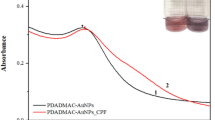Abstract
Malathion is one of the most commonly used organophosphorous pesticides worldwide. Gold nanoparticles can be used for the degradation and removal of 10 ppm malathion. The morphology of the prepared gold nanoparticle is characterized by transmission electron microscopy. Photodegradation of malathion on irradiation to different light sources was monitored using different tools such as UV–visible spectra and high-performance liquid chromatography. Photodegradation rate of malathion was enhanced in the presence of gold nanoparticles as a result of surface plasmon phenomena.






Similar content being viewed by others
References
Smith J, Jones M Jr, Houghton L et al (1999) Future of health insurance. N Engl J Med 965:325–329
Link S, El-Sayed MA (2003) Optical properties and utrafast dynamics of metallic nanocrystals. Annu Rev Phys Chem 54:331–366
Mohamed MB, Volkov V, Link S et al (2000) The ‘lightning’ gold nanorods: fluorescence enhancement of over a million compared to the gold metal. Chem Phys Lett 317:517–523
Mohamed MB, Ahmadi TS, Link S et al (2001) Hot electron and phonon dynamics of gold nanoparticles embedded in a gel matrix. Chem Phys Lett 343:55–63
Haruta M (1997) Size- and support-dependency in the catalysis of gold. Catal Today 36:153–166
Valden M, Lai X, Goodman DW (1998) Onset of catalytic activity of gold clusters on titania with the appearance of nonmetallic properties. Science 281:1647–1650
Min BK, Friend CM (2007) Heterogenous gold based catalysis for green chemistry: low temperature co-oxidation and propene oxidation. Chem Rev 107:2709–2724
Sonawane RS, Dongare MK (2006) Sol–gel synthesis of Au/TiO2 thin films for photocatalytic degradation of phenol in sunlight. J Mol Catal A Chem 243:68–76
Mrowetz M, Villa A, Prati L, Selli E (2007) Effects of Au nanoparticles on TiO2 in the photocatalytic degradation of an azo dye. Gold Bull 40:154–160
Bohren CF, Huffman DR (1983) Absorption and scattering of light by small particles. Wiley, New York
Mulvaney P (2006) Surface plasmon spectroscopy of nanosized metal particles. Langmuir 12:788–800
Gupta PK (2004) Pesticide exposure - Indian scene. Toxicology 198:83–90
Mohammadi MR, Cordero-Cabrera MC, Fray DJ, Ghorbani M (2006) Preparation of high surface area titania (TiO2) films and powders using particulate sol–gel route aided by polymeric fugitive agents. Sensor Actuat B-120:86–95
Zeljezic D, Garaj-Vrhovac V (2002) Evaluation of genetic damage in workers employed in pesticide production utilizing the Comet assay. Chemosphere 46:295–303
Fouad DM, Mohamed MB (2011) Photodegradation of chloridazon using coreshell magnetic nanocomposites. J Nanotechnol 2011:7. doi:10.1155/2011/416060, Article ID 416060
Fouad DM, Mohamed M (2011) Studies on the photo-catalytic activity of semiconductor nanostructures and their gold core–shell on the photodegradation of malathion. Nanotechnology 22:1–9
Turkevich PCJ, Stevenson JH (1951) A study of the nucleation and growth processes in the synthesis of colloidal gold. Discuss Faraday Soc 11:55–75
Neppolian B, Haeryong J, Heechul C (2007) Photo degradation of 4-chlorophenol using TiO2 and Pt-TiO2 nanoparticles prepared by sol–gel method. Photo J Adv Oxi Technol 10:1–6
Neppolian B, Choi HC, Sakthivel S, Arabindoo B, Murugesam V (2002) Solar light induced and TiO2 assisted degradation of textile dye reactive blue 4. Chemosphere Ref Data 46:1173–1181
Herrmann JM (1995) Heterogeneous photocatalysis: an emerging discipline involving multiphase systems. Cat Today 24:157–164
El-Sayed MA (2001) Some interesting properties of metals confined in time and nanometer space of different shapes. Accounts of Chemical Research 34:257–264
Kreibig U, Vollmer M (1995) Optical properties of metal clusters. Springer, New York
Kelly KL et al (2002) The optical properties of metal nanoparticles: the influence of size, shape, and dielectric environment. J Physical Chem B 107:668–677
Xie Y, Yuan C (2004) Photocatalysis of neodymium ion modified TiO2 sol under visible light irradiation. Appl Surf Sci 221:17–24
Hariharan C (2006) Photocatalytic degradation of organic contaminants in water by ZnO nanoparticles: revisited. Appl Catal Gen 304:55–61
Giorgetti E, Giusti A, Giammanco F, Laza S et al (2007) Photodegradation of PAMAM g5-stabilized aqueous suspensions of gold nanoparticles. Appl Surf Sci 254:1140–1144
Min BK, Heo JE, Youn NK et al (2009) Tuning of the photocatalytic1,4-dioxane degradation with surface plasmon resonance of gold nanoparticles on titania. Catal Commun 10:712–715
Author information
Authors and Affiliations
Corresponding author
Rights and permissions
About this article
Cite this article
Fouad, D.M., Mohamed, M.B. Malathion-Induced Surface Coupling with Gold Nanoparticles. Plasmonics 8, 937–941 (2013). https://doi.org/10.1007/s11468-013-9493-2
Received:
Accepted:
Published:
Issue Date:
DOI: https://doi.org/10.1007/s11468-013-9493-2




